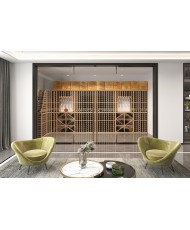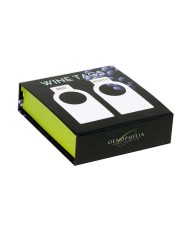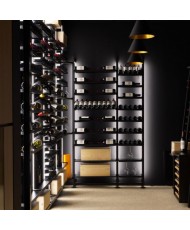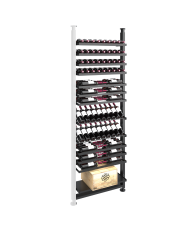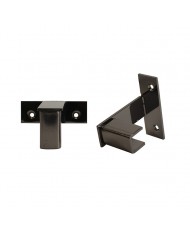DESIGN YOUR OWN CELLAR ON PAPER OR WITH SOFTWARE
Paper Scale Templates (Available at bottom of page)
- Scaled worksheet
- Cutting elements Kit Rack Elite

Design your own wine cellar with our chart paper and modular wine rack sheets. Rearrange the elements to your heart's content before settling on your final design.
You can design your own wine cellar by printing out our chart paper and modular wine rack sheets. It's really easy to do and can be a rewarding exercise for those who enjoy DIY.
Before you start, you need to choose the product line you want to use:
Kit Rack or Kit Rack Elite
NOTE: These two product lines cannot be combined
Step 1. Measure your wine cellar as accurately as possible in all three dimensions. Make notes on doors, light fixtures, outlets, switches and other elements that might affect your design choices.
Step 2. Download and print our Genuwine 1/2" graph paper. You will need one copy for the aerial view and an additional copy for each wall of your cellar that you plan to install shelving on. All of our components are provided in both aerial (plan) and front (elevation) views. The scale for all these sheets is 1/2" = 1 foot.
NOTE: When printing one of our Genuwine paper design pages, you should not use print options that may "fit" or "shrink" or otherwise size the image. Print the image on letter-size paper without settings. (or select "Actual Size" if available).
Step 3. Download and print the component sheets for the product line you have chosen. It is helpful to have multiple copies printed as your winery will likely use the same components more than once.
Step 4. Transfer your measurements (and notes) from Step 1 to graph paper and label each sheet accordingly. If you know the cardinal directions of your room, then the North, South, East, and West labels are a great way to keep track of what you are looking at. On the aerial view, mark the north side as well.
Step 5. Using scissors or an art knife on a suitable cutting surface, cut out the individual components of the rack. Be sure to leave the labels attached to their modules!
Step 6. Design your basement by arranging and rearranging the components on the graph paper that has your measurements. Once you have established your final design, make it permanent with tape, sticker or glue stick.
It should look something like this!

If you are satisfied at this point, and you can see your wine cellar in your mind, simply take the next step of creating a shopping list from your design and order your components here on this site. But before you do, please consider accessories such as molding, bin dividers or a corner rack.
Kit Rack Accessories
(NOTE: Molding and bin dividers are not included in Rack Kit modules)
Kit Rack Elite Accessories
(NOTE: Kit Rack Elite modules are supplied with unit width moldings and bin dividers where applicable).
At its core, a wine cellar is simply any place designated for storing a wine collection. It can range from a sophisticated, state-of-the-art 8,000-bottle case featured in a design magazine, to a dank and dirty underground dugout, to a set of modular wooden racks in the corner of an unfinished basement. Traditionally, a wine cellar was considered something located underground, but today that distinction is less applicable.
While the ultimate purpose will always be to store wine (ideally in proper conditions), a cellar can also be a place to entertain guests, a beautiful object of desire to show off, a protective sanctuary for a valuable investment, or a combination of these.
Whatever uses you might have for it, it's important to keep in mind that wine is a perishable product and its protection should always be paramount. Filling a fancy room with wine racks is one thing. Making a great cellar that is also fully functional is another. Remember, you're spending as much money on wine as you are on your cellar, so make an effort to protect your future investment. When stored properly, wines not only retain their quality, but also improve in aroma, flavor and complexity as they mature.
If you don't focus on the wine when building a cellar, it can be a disaster.
The principles of a good wine cellar all follow the same logic: protect the wine from harmful influences. Here are the main dangers to avoid:
1) Temperature
Wine can be damaged if it is subjected to extreme temperatures. If a cellar becomes too hot (over 25°C (77°F) for long periods of time, it can spoil or "cook" the wine. Restaurants with limited storage space are often guilty of this crime, storing their wine in stuffy kitchens. For the same reason, a home cellar should never be built next to a fireplace or furnace.
If the cellar gets too cold, a wine can freeze, which can ravage the cork and introduce oxygen into the wine, a result that can be disastrous if the exposure is too great.
So what is the ideal temperature for storing wine? Although this is a subject of debate among wine professionals, it is safe to say that wine can be stored satisfactorily between 7 and 18°C (45 and 64°F). Some argue that the absolute perfect temperature for storing and aging wine is 13°C (55°F), which is about the same temperature as in many cellar caves in France, but ultimately as important as maintaining consistency. In other words, it is better to be a little warmer (or colder) as long as your cellar maintains this same temperature. If the temperature fluctuations are too drastic, we run into cork problems again and run the risk of oxidizing the bottles in your collection.
Finally, a wine has a greater potential to develop complexity and a more aromatic bouquet if it is allowed to age slowly. Lower temperatures slow down the wine's aging cycle, so it stands to reason that a cellar is better on the cooler side than the warmer, especially if you appreciate all the wonderful tertiary characteristics that aged wine can bring.
2) Humidity
Humidity becomes a problem for wine when conditions are too dry, or when the relative humidity fluctuates too much. In dry conditions, a cork can become susceptible to damage. This is why you should not age wine in a normal refrigerator (the lack of humidity dries out the cork, which can increase the risk of oxidation) and why you should always place your bottles horizontally, so that the wine is always in contact with the cork to keep it moist.
Regulating the ambient humidity of a wine cellar is often the most difficult environmental consideration to avoid, unless, of course, you are in a constantly humid climate, like England.
If, however, you live in drier climates, you may need to regulate ambient humidity. This can be as simple (if not messier) as covering your cellar floor with an inch of gravel and watering it periodically, or as sophisticated as enclosing your space and using a state-of-the-art temperature control system. A good wine cellar must be highly insulated and must be properly constructed. They require specialized wine cellar conditioning and cooling systems to maintain the desired temperature and humidity.
75% humidity is often cited as the best, but anything between 50% and 75% is more than adequate. Anything too humid and the labels could be damaged, which will greatly affect the value of the investment wines.
Lastly, maintaining good air circulation and ventilation is also important, not only to keep the cellar a pleasant place to visit, but to keep it free of lingering odors, which could affect the wine.

 Do you have any questions?
Do you have any questions?
 Free delivery
Free delivery
 We want your feedback!
We want your feedback!






.png)





